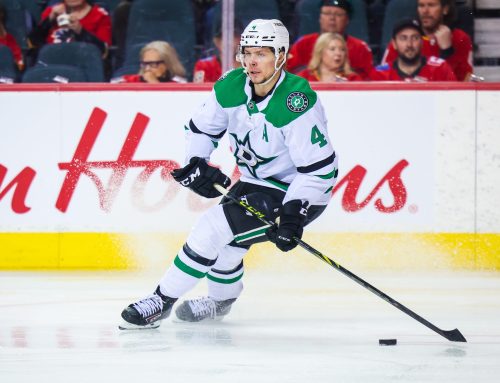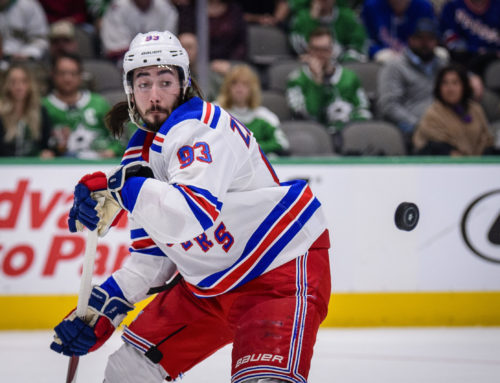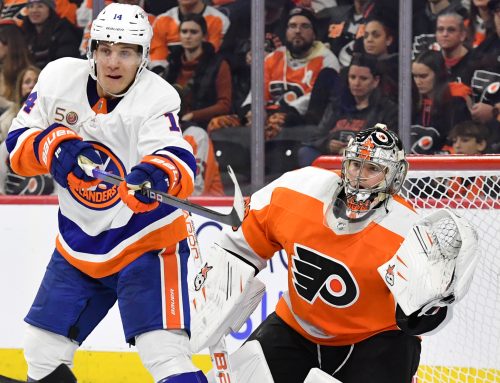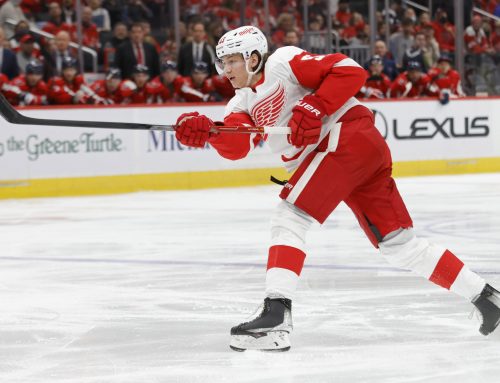Cage Match: Torey Krug vs Tyson Barrie
Rick Roos
2019-01-23

With my last defensemen battle coming way back in August, I figure another was overdue. And this is a doozy, pitting Torey Krug against Tyson Barrie. Both are reliable sources of blueline offence, but which one is better at present and going forward? Let’s find out – Cage Match starts now!
Career Path and Contract Status
Krug, 27, went undrafted but was a highly sought-after commodity after seeing his point total increase with each passing season in college. He signed with Boston in March 2012 and paid dividends by scoring four goals in his first five playoff games, cementing his spot with the Bs. Over his first three full seasons, Krug was solid but unspectacular, scoring 39-44 points per campaign. But as Zdeno Chara’s role diminished Krug stepped up. First, it was with 51 points in 2016-17, then 59 in only 76 contests last season – including 37 points in his last 38 games. This season he’s stayed just as hot despite missing 11 games in the first half.
Barrie, also 27, was selected 64th overall in the 2009 entry draft and posted a cumulative 130 points in 117 games in his age 18 and 19 WHL seasons. He split the next two seasons between the AHL and NHL before spending most of 2013-14 with the Avs and producing much better (38 points in 64 games). Now settled in the NHL, Barrie took things to another level with 53 points in 2014-15. But rather than being able to use that as a springboard to fantasy stardom, Barrie instead saw his scoring rate stay in neutral in 2015-16 (49 points in 78 games) and then drop to 38 points in 74 games in 2016-17. But to say he rebounded last season would be a vast understatement, as he posted a career-high 57 points. However, those came in only 68 games, marking the second straight season where he missed eight-plus games.
Krug has one year left on a deal that dings the cap at $5.2M per campaign, whereas Barrie is inked for two more seasons with an annual cap hit of $5.5M. Each will be a UFA when his current contract ends.
Ice Time (Data in this and the other tables is current through January 20th)
|
Season |
Total Ice Time per game (rank among team’s forwards) |
PP Ice Time per game (rank among team’s forwards) |
SH Ice Time per game (rank among team’s forwards) |
|
2018-19 |
21:49 (T.K.) – 1st 21:52 (T.B.) – 2nd |
3:52 (T.K.) – 1st 4:21 (T.B.) – 1st |
0:19 (T.K.) – 10th 0:07 (T.B.) – 8th |
|
2017-18 |
20:24 (T.K.) – 3rd 22:42 (T.B.) – 2nd |
3:26 (T.K.) – 1st 3:44 (T.B.) – 1st |
0:22 (T.K.) – 7th 0:11 (T.B.) – 10th |
|
2016-17 |
21:36 (T.K.) – 2nd 23:18 (T.B.) – 1st |
3:16 (T.K.) – 1st 3:04 (T.B.) – 1st |
0:23 (T.K.) – 7th 0:33 (T.B.) – 8th |
|
2015-16 |
21:37 (T.K.) – 2nd 23:12 (T.B.) – 3rd |
3:18 (T.K.) – 1st 3:08 (T.B.) – 1st |
0:38 (T.K.) – 7th 0:40 (T.B.) – 7th |
Both see tons of minutes and are saddled with next to no SH duty, which is unusual for rearguards. In fact, so rare is their deployment that not only are both the only defensemen – in each of the last three seasons plus this season thus far – to average 20+ minutes per game of which over 3:15 came on the PP but also no more than 40 seconds was on the PK. There have been a total of only six other instances of any defenseman in all of the NHL meeting all three criteria in any one of the past three seasons plus this season. Let that sink in for a moment, then smile ear to ear if you own Krug or Barrie.
In terms of Krug, this quells concern as to his ice time being harmed by the arrival of youngster, Charlie McAvoy. While McAvoy did take the ice more overall than Krug last season, that’s not the case for this season thus far; and as we can see, Krug’s deployment is best this season and last despite McAvoy’s arrival. If anything, the presence of McAvoy has given Boston the ability to pigeonhole Krug even more into a one-dimensional, fantasy-helpful d-man whose main purpose is to help generate offence.
As for Barrie, the concern is how – despite superb deployment – did he manage to score only 38 points in 74 games in 2016-17? If we dig deeper, it turns out Barrie was just as productive but victimized by a lousy team around him – one which scored a mere 165 goals that entire season, which was a big drop as compared to 212 in 2015-16, and nearly 100 less than the 255 they tallied last season. In looking at Barrie’s 82 game scoring pace versus goals scored by the team each season, it turns out Barrie nabbed a point on 24% in 2015-16, 25% in 2016-17, and 26% in 2017-18. So Barrie’s scoring rate for 2016-17 was in line with his other campaigns – he was just brought down by the woeful team around him. That goes a long way toward erasing concern about Barrie’s 2016-17 production and bodes extremely well for him for the rest of 2018-19 considering Colorado is on pace for 283 goals, which would top their 2017-18 output by more than 10%.
Secondary Categories
|
Season |
PIMs (per game) |
Hits (per game) |
Blocked Shots (per game) |
Shots (per game) |
PP Points (per game) |
|
0.60 (T.K.) 0.32 (T.B.) |
0.84 (T.K.) 0.54 (T.B.) |
0.89 (T.K.) 0.91 (T.B.) |
2.44 (T.K.) 2.59 (T.B.) |
0.50 (T.K.) 0.38 (T.B.) |
|
|
2017-18 |
0.47 (T.K.) 0.32 (T.B.) |
1.04 (T.K.) 0.59 (T.B.) |
0.96 (T.K.) 1.16 (T.B.) |
2.59 (T.K.) 2.61 (T.B.) |
0.31 (T.K.) 0.44 (T.B.)
📢 advertisement:
|
|
2016-17 |
0.46 (T.K.) 0.24 (T.B.) |
0.72 (T.K.) 0.43 (T.B.) |
1.02 (T.K.) 1.01 (T.B.) |
2.58 (T.K.) 2.46 (T.B.) |
0.31 (T.K.) 0.13 (T.B.) |
|
2015-16 |
0.40 (T.K.) 0.39 (T.B.) |
0.75 (T.K.) 0.47 (T.B.) |
1.16 (T.K.) 1.07 (T.B.) |
3.01 (T.K.) 2.20 (T.B.) |
0.23 (T.K.) 0.27 (T.B.) |
Barrie’s SOG and PPPts trends are consistent with a player who’s upped his production within the past two seasons, as both per game averages have spiked as compared not just to the down season of 2016-17 but also 2015-16. The same, however, cannot be said for Krug, whose SOG rate has dropped by more than half a shot per game since as recently as 2015-16, although this season has seen his PPPt rate nearly double versus his average of the past three campaigns, begging the question as to sustainability.
In fact, looking at some of the best rearguard PP producers since 2010-11, none who played 65+ games have finished a season with one PPPt per every other contest as Krug is averaging now. In fact, Barrie’s rate of 0.44 PPPts per game last season ranks as second best (behind only the 39 PPPts in 82 games for Niklas Lidstrom way back in 2010-11). Moreover, there were only two other instances of 0.40 PPPts per game (in 65+ games) over this stretch of seven full seasons.
What this suggests is Krug’s current PP scoring rate is bound to drop, leading to his scoring rate dropping as well. It also adds more legitimacy to Barrie’s 2018-19 scoring rate since his PPP rate is below that 0.40 per game threshold plus, as noted above, has come with his SOG rate staying constant.
As for their other multicat outputs, Krug is the better of the two in PIM and Hits, while both have comparable Blocks. And although their contributions in these three categories won’t put you over the top, they won’t really drag you down either, especially given how great both are in scoring categories.
Luck-Based Metrics
|
Season |
Team Shooting % (5×5) |
Individual Points % (IPP) |
Offensive Zone Starting % (5×5) |
Secondary Assists % |
|
2018-19 |
6.90% (T.K.) 8.31% (T.B.) |
55.2% (T.K.) 54.4% (T.B.) |
65.3% (T.K.) 62.0% (T.B.) |
48% (T.K.) 40% (T.B.) |
|
2017-18 |
7.73% (T.K.) 9.25% (T.B.) |
54.6% (T.K.) 57.0% (T.B.) |
64.7% (T.K.) 61.4% (T.B.) |
42% (T.K.) 44% (T.B.) |
|
2016-17 |
5.71% (T.K.) 6.74% (T.B.) |
53.7% (T.K.) 58.5% (T.B.) |
58.7% (T.K.) 56.8% (T.B.) |
42% (T.K.) 35% (T.B.) |
|
2015-16 |
7.57% (T.K.) 8.74% (T.B.) |
44.4% (T.K.) 50.5% (T.B.) |
53.7% (T.K.) 47.2% (T.B.) |
35% (T.K.) 44% (T.B.) |
In case the smiles you had after seeing their ice times and deployments might have started to fade, they should return mighty quick based on the offensive zone starting percentages for both over the past two seasons. Put it this way – those percentages would be high if they were forwards; for defensemen, they’re downright stratospheric! And more importantly, they’re a gold mine in terms of the scoring potential they provide, as this all but confirms these two are put on the ice to generate offence, with defensive responsibility more of a secondary consideration.
For Barrie, the data that also sticks out is his IPP being above 50.0% in each of the last three seasons plus this season thus far. That’s no small task, as for the past three seasons, respectively, there’ve been 16, 12 and 10 defenders who’ve played in 60+ games and had above a 50.0%+ IPP, and for 2018-19 thus far only 17 others who’ve played 35+ games also have an IPP above 50.0%. Moreover, Barrie has had great IPPs on both bad teams and good, further emphasizing his consistency. On top of this, Barrie’s highest 5×5 team shooting percentage came in that dismal 2016-17 season for the Avs. What that proves – in addition to the data above about his rate of points per team goals staying consistent year to year – is when the team’s forwards were failing, it was Barrie who was still out there producing. And in other seasons his team shooting percentage rates were still higher than we see for most d-men, further showing that Barrie is an offensive conduit. So to summarize, Barrie has a high rate of offensive zone starts, generates offence when on the ice and finds a consistent way to factor into scoring at a very high rate for d-men. In other words, he’s a very, very valuable fantasy player. What’s more, he should be able to perform this way for any team, as these metrics are seemingly not tied to him being on the Avs.
What of Krug? His team shooting percentage lags somewhat behind Barrie’s despite receiving a higher OZ% than Barrie in each of the past three seasons, plus for 2018-19 thus far. If we were comparing Krug to nearly any other player, chances are his metrics would put him ahead; yet here they’re not quite in the same echelon as Barrie’s. Also, as great as Krug’s OZ% is, he’s hitting unrestricted free agency in 2020, and chances are Boston will let him walk given the price he’ll command not to mention McAvoy waiting in the wings and set to hit his prime. And if Krug goes to a new team as a UFA, who’s to say he’ll still get this dream deployment? And if he doesn’t, will he revert to his past less gaudy numbers? Granted, Barrie is a UFA in two seasons; however, there’s no McAvoy type on the Avs, so Barrie stands a better chance of re-upping, in which case he should be able to continue what he’s doing now.
Who Wins?
The beauty of fantasy hockey is one-dimensional players can be more valuable than those who check “real life” boxes. And here we have a battle between two of the most one-dimensional d-men not just of today but, as shown by the data cited above, of recent memory. But in a Cage Match there can be only one winner; and based on how the last section ended, you can probably guess the victor here is Barrie. Simply put he gives you all Krug does, plus just a bit more. Moreover, Krug likely will find himself on a new team as a UFA, where his deployment might not be so amazing, whereas Barrie has a decent chance of staying with the Avs, who’ll probably be more than happy for him to keep doing what he’s doing and, in furtherance of that happening, keep giving him pretty much the best fantasy deployment you’ll find in today’s NHL.





 BUF
BUF N.J
N.J PHI
PHI MIN
MIN VAN
VAN FLA
FLA TOR
TOR CGY
CGY NYR
NYR